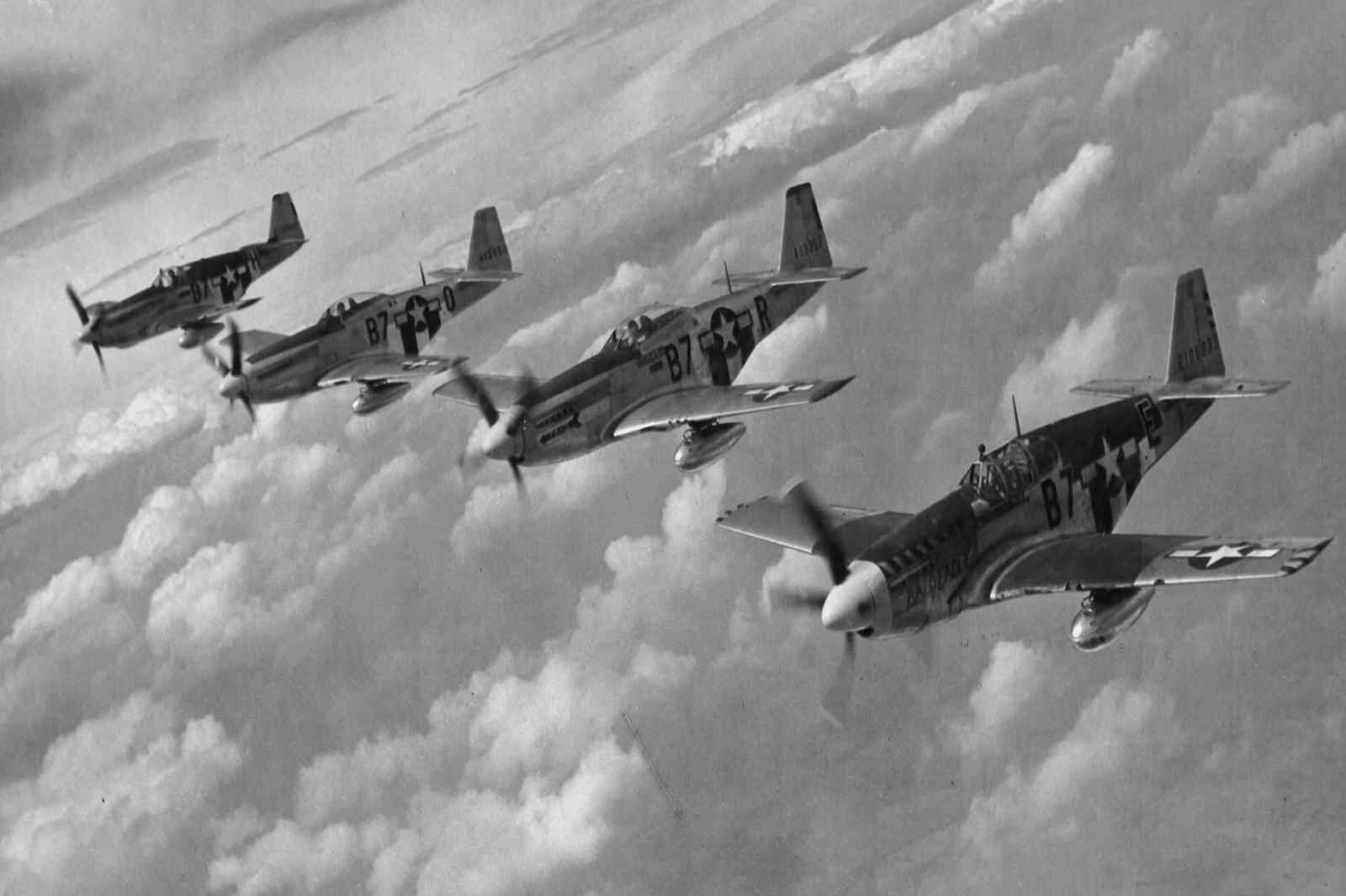
Fighters
WWI & WWII Fighter Airplanes
-
MIG – 3
Designed for high altitude combat, the Mig-3 was usually forced into roles which resulted in inferior performance. An excellent aircraft above 12,000 feet, its performance was seriously diminished at lower altitudes. According to one pilot, the Mig-3 flew like “a cow” below that altitude. It was a demanding plane to fly in any configuration, and it was relegated to defensive units fairly early in the war.The museum’s Mig-3 is the only flying Mig-3 anywhere in the world.
Country: Russia
Manufacturer: Mikoyan-Gurevich
Engine: Mikulin AM35-A
Horsepower: 1350 hp
Max Speed: 398 mph
Empty Weight: 5,965 lbs
Max Weight: 7,415 lbs
Ceiling: 39,400 feet
Crew: One
Armament: 1 x 12.7 mm MG, 2 x 7.62 mm MGs, 2 x 200 lbs bombs -
Me-262 Schwalbe
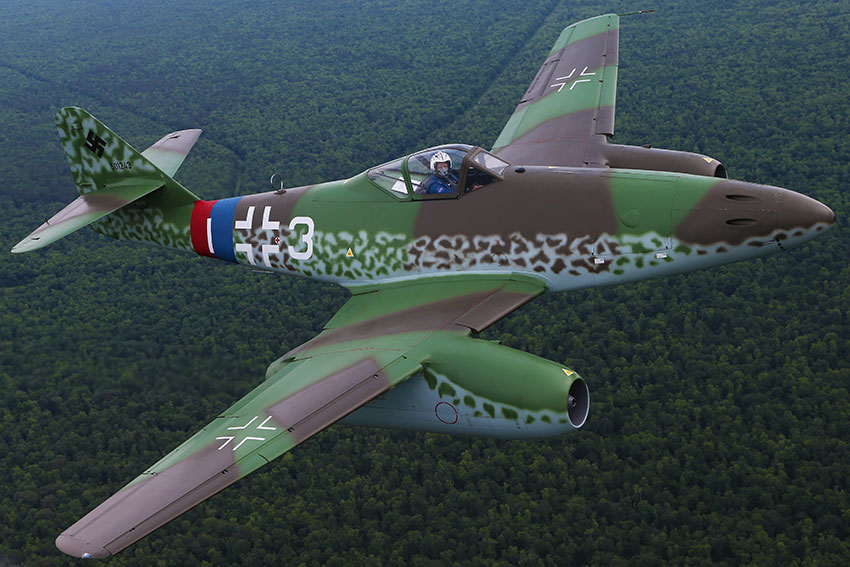
The Me-262 “Schwalbe” (Swallow) was the world’s first operational combat jet. As such, it immediately outclassed all piston fighters and would have been a serious threat if it had been available in significant numbers. The design predated WWII, but engine difficulties delayed operational status until mid-1944.No original Me-262s are still airworthy. The museum’s aircraft was reconstructed and first flown in 2011. It is painted as “White 3”, flown by Ens. Hans Guido Mutke of JG 7, the most successful Me-262 squadron during the war. Guido Mutke visited our museum several years ago, before he passed away.
Country: Germany
Manufacturer: Messerschmitt
Engine: Dual Junkers Jumo Turbo Jets
Thrust: 8.8 kN (1,984 lbf)
Max Speed: 426 mph
Empty Weight: 8,366 lbs
Max Weight: 15,720 lbs
Ceiling: 37,565 feet
Crew: One
Armament: 4 x 30mm Mk 108 cannons, various payload of rockets or bombs -
w-190 Dora
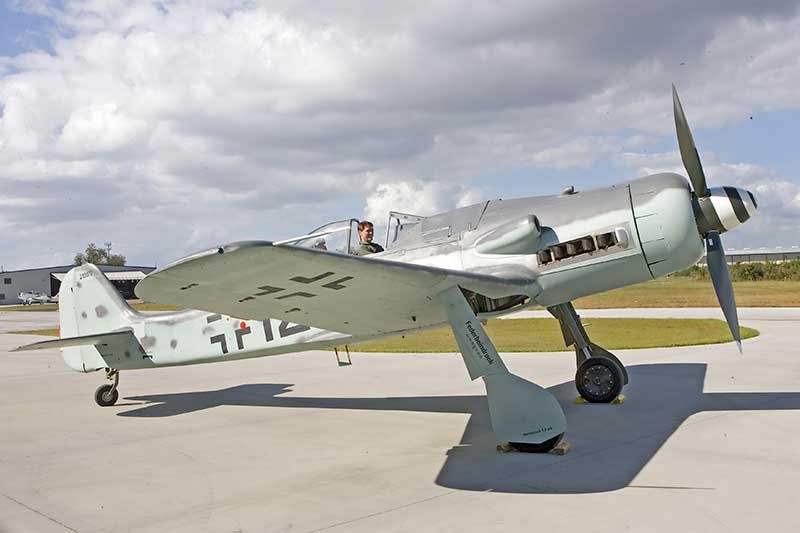
The D-9 “Dora” or “long-nose” version of the Fw-190 was intended to improve the higher altitude performance of the aircraft. Many Fw-190 D’s were constructed at a final assemly plant in the hangars of Cottbus. Originally the Dora was used by the German Luftwaffe to combat high-altitude bombers. As the air war evolved, the “Dora” was more typically involved in fighter-to-fighter operations.
The museum’s “Dora” is a reconstruction painted in the “Black 12” livery of Lt. Theo Nibel of JG 54. During Operation Bodenplatte, Germany’s last major aerial offensive of WWII, Nibel made a successful forced landing after a bird strike crippled his aircraft.
Country: Germany
Manufacturer: Focke-Wulf Flugzeugbau
Engine: Junkers Jumo 213 A-1
Max Speed: 426 mph
Empty Weight: 7,694 lbs
Max Weight: 10,670 lbs
Ceiling: 39,370 feet
Crew: One
Armament: 2 x 20 mm MGs, 2 x 13 mm MGs, 1 x 1,000 lbs bomb -
Supermarine Mk 1Xe Spitfire
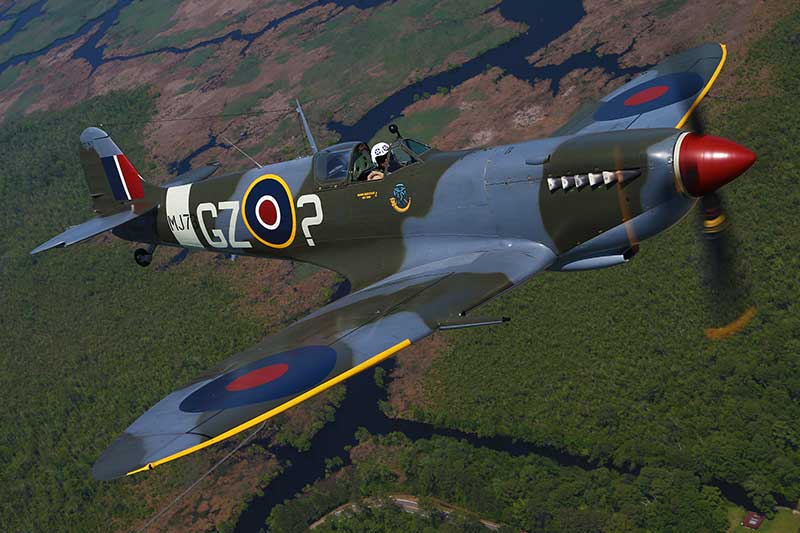
The Spitfire, along with the Mustang, are the best WWII examples of the old adage “If it looks good, it will fly good”. First flown in 1936, the Spitfire went through an astonishing number of variants and was used by more than 36 countries for several decades past war’s end.
Shipped to Casablanca in 1944, the MAM’s Spitfire served in North Africa, Italy, Corsica, Greece, and Yugoslavia during the war, and Italy and Israel after the war. It’s final service prior to restoration was as a dilapidated playground attraction in an Israeli kibbutz.
The unique markings of “The CO’s Query” are those of the Squadron Commander George Silvester (DFC) of RAF 32 Squadron assigned to Kolomaki, Greece.
Country: UK
Manufacturer: Vickers Supermarine
Engine: Rolls Royce Merlin
Horsepower: 1,760 hp
Max Speed: 312 mph
Max Weight: 7900lbs
Empty Weight: 5600
Ceiling: 43,000 feet
Wing Span: 36′ 10″
Length: 31′ 1″
Crew: One
Arament: 2 x .50 cal MGs, 2 x 20mm cannons -
Hawker Hurricane
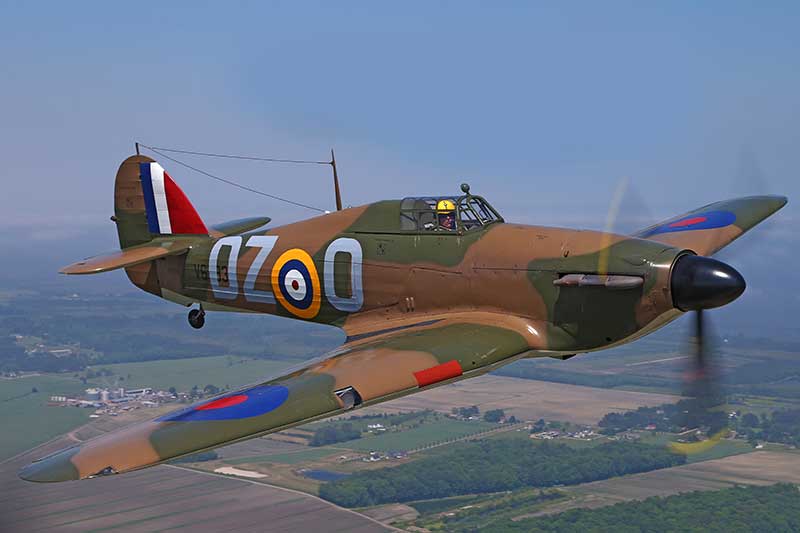
The Hawker Hurricane was originally designed in 1934 as an updated monoplane version of the Hawker Fury (also in the MAM collection). It first flew the next year.
It could be argued that Britain would have lost the war in 1940 without this plane. During the Battle of Britain, when that country fought alone against expected invasion, the Hurricane was flying in greater numbers than the more popular Spitfire, and accounted for 80% of enemy planes destroyed.
The MAM Hurricane was built in 1943 as one of the 1,451 planes built in Canada, and it is almost completely in it’s original condition. The livery is that of Pilot Officer John Kenneth Haviland, the only U.S.-born RAF pilot who flew in the Battle of Britain that survived the war. Haviland returned to the U.S. and retired as Professor Emeritus at the University of Va.
Country: UK
Manufacturer: Hawker
Engine: Packard Merlin 29
Horsepower: 1,280 hp
Max Speed: 340 mph
Weight: 5,668lbs/8,600lbs
Ceiling: 36,000 feet
Range: 315 miles
Armament: 12 Browning .303 gunsFuel Capacity: 113 U.S. GallonsFuel Use: 60 gals. per hour
Crew: One -
P-51 Mustang
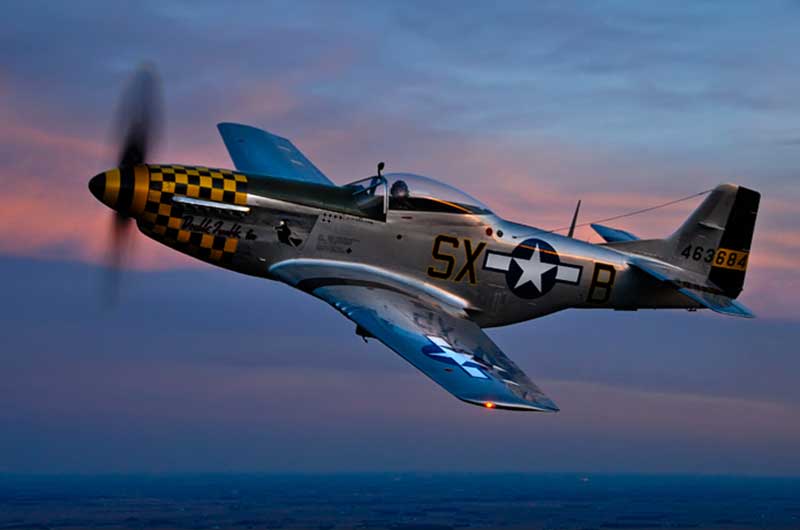
Designed in in 1940 with the flying prototype built in under 120 days to British specs, the Mustang proved to be capable but somewhat underpowered, particularly at altitude.
The RAF and AAC tested replacing the Allison engine with Merlin engines, and a legend was born. First operational with U.S. forces in June 1944 in its new configuration, the Mustang now had the speed, range, and firepower to master the skies over Europe, allowing the survival of daylight bombing.
MAM’s P-51D was built in 1945 and was immediately sent to England to the 8th Air Force. Markings belong to the Deputy Commander of the 353rd Fighter Group. In post-war years it served in the air forces of Sweden and Nicaragua.
Country: USA
Manufacturer: N. American
Engine: Packard V 1650
Horsepower: 1,490 hp
Max Speed: 437 mph
Weight: 12,100 bs /7,125 lbs
Ceiling: 43,000 feet
Range: 1000 miles
Wing Span: 37′ .5″
Length: 32′ 2.5″
Crew: One
Armament: 6 x .50 cal MGs, 6 x H.V.A.R rockets, 2 x 1,000 lbs. bombs -
FG-1D “Corsair”

One of the most powerful and unique fighter aircraft of the war is undoubtedly the instantly recognizable “gull-wing” Corsair. Designed by the Vought Aircraft Company, demand was such that production was also licensed to Goodyear and Brewster.
Known to pilots as “hose-nose” and to the Japanese as “Whistling Death”, the Corsair had birthing difficulties as a carrier-based aircraft, but saw immediate success as a ground-based fighter as popularized by Maj. Greg Boyington and the “Black Sheep” Squadron of television fame.
MAM’s Corsair was delivered in May of 1945, and spent much of it’s military career in storage, being one of the lowest time Corsairs known. The “Skull and Bones” livery is that of Norfolk-born Ray Beacham, who flew with the famous VF-17 in the Pacific.
Country: USA
Manufacturer: Goodyear
Engine: Pratt & Whitney R2800
Horsepower: 2,000 hp
Max Speed: 425 mph
Weight: 5448 lbs / 8,271 lbs
Ceiling: 35,600 feet
Range: 1000 / 2100 miles
Crew: One
Armament: 6 x .50 cal MGs, 8 x H.V.A.R rockets, 2 x 1,000 lbs .bombs -
Curtiss P-40E Warhawk
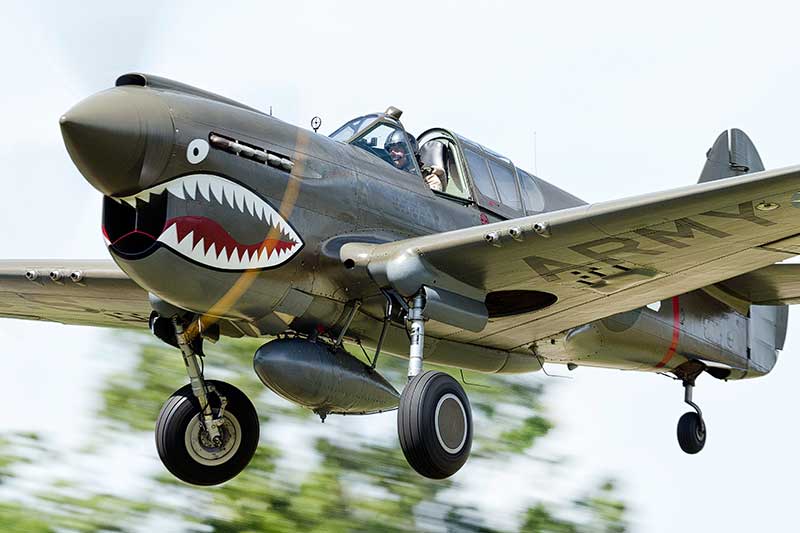
The Curtis P-40, first flown in 1938, saw service in most WWII theaters. As one of few fighters available at the beginning of the war, they were sent under lend-lease to Britain and the Soviet Union as well as serving famously with the American Volunteer Group, the Flying Tigers. Our aircraft carries the livery of AVG legend “Tex” Hill.
In the U.S. all P-40’s were “Warhawks”, but later variants were called “Kittyhawks” by other nations. The P-40 was almost obsolete at the beginning of the war, but with the right tactics, it was still capable of great impact.
The MAM’s P-40 was built in 1941, and was sent to Great Britain, then on to the Soviet Union to a squadron near Murmansk where it was lost in action and restored 50 years later. It returned to the skies after extensive reconstruction in 2003.
Country: USA
Manufacturer:
Engine: Allison V1710
Horsepower: 1,350 hp
Max Speed: 378 mph
Weight: 6200 lbs
Ceiling: 43,000 feet
Range: 650 miles
Wing Span: 37′ 3.5″
Length: 31′ 8.5″
Height: 10′ 8” -
FM-2 Wildcat
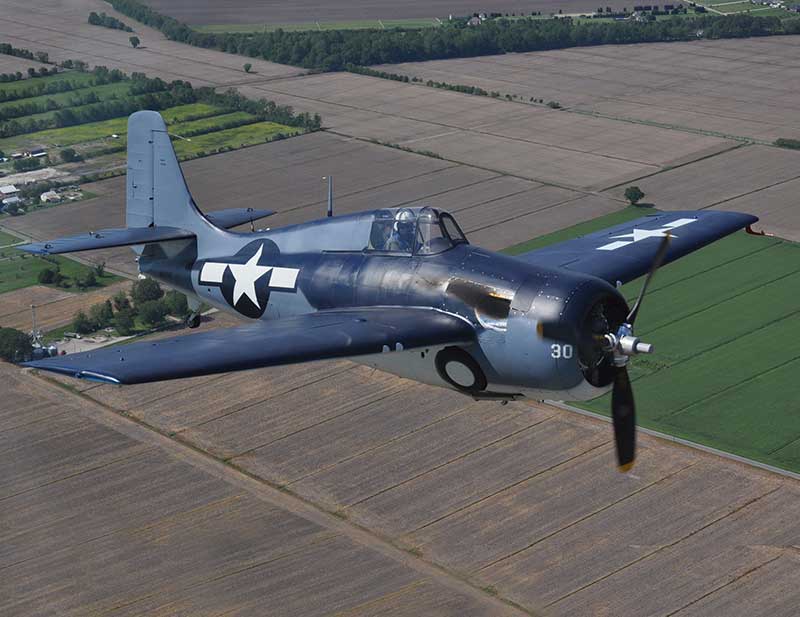
The Wildcat was an American carrier-based fighter built by Grumman that entered service in 1940 with the U.S. Navy and the British Royal Navy (as the “Martlet”). In the Pacific, it was the only fighter available in the early war, and it was only with superior tactics that it achieved a 6:1 kill ratio in the first year of the war.
Lessons learned from the Wildcat led to the Grumman Hellcat, but the Wildcat continued to serve throughout the war on “jeep” carriers that were too small to take on larger aircraft. Wildcats built under license by GM were designated FM-2 as distinct from the Grumman F4F
No less an authority than British test pilot Eric Brown said “I would still assess the Wildcat as the outstanding naval fighter of the early years of WWII …this Grumman fighter was one of the finest shipboard aeroplanes ever created.
Country: USA
Manufacturer: Grumman (F4F) and General Motors (FM-2)
Engine: Pratt & Whitney 1830
Horsepower: 1,200 hp
Max Speed: 332 mph
Weight: 8,271 lbs
Ceiling: 39,500 feet
Range: 900 miles
Wing Span: 38′
Length: 28′ 9″
Crew: One
Armament: 6 x .50 cal MGs, 6 x H.V.A.R rockets, 2 x 1,000 lbs. bombs -
P-26 “Peashooter”
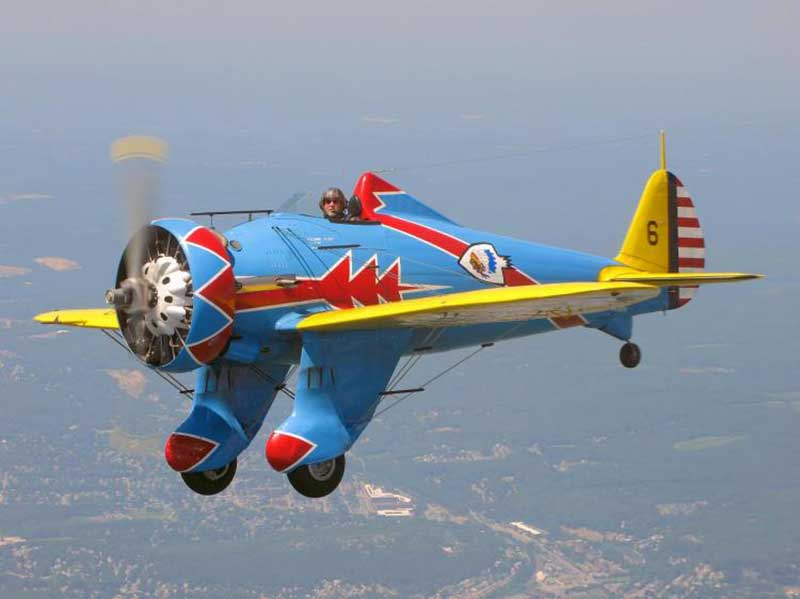
The Boeing P-26 “Peashooter” was the first all-metal production fighter aircraft, and was also the first “pursuit” monoplane used by the U.S. Army Air Corps. To add to the list of “firsts”, it was also the debut of flaps to reduce landing speeds. Sadly, it was the last fighter built by Boeing.
The prototype first flew in 1932, and the type was still in use in the Philippines as late as 1941. The unusual high-back canopy , which was armored, was added due to the planes unfortunate tendency to flip over after a bad landing due to the short nose.
Despite the small production, the type actually served until 1956 with the Guatemalan Air Force. MAM’s replica P-26 was built completed in 2006, and is painted to represent the 1st Pursuit Group, 94th Pursuit Squadron circa 1935-36.
Country: USA
Engine: Pratt & Whitney R-1340-7 “Wasp” radial engine
Horsepower: 600 hp
Max Speed: 234 mph
Weight: 3,360 lbs
Ceiling: 27,400 feet
Wing Span: 28 ft
Length: 23 ft
Height: 10 ft
Combat Radius: 360 miles
Crew: One
Armament: Two .30 inch M1919, Browning machine guns, One 200lb bomb -
Bell P-63 “Kingcobra”
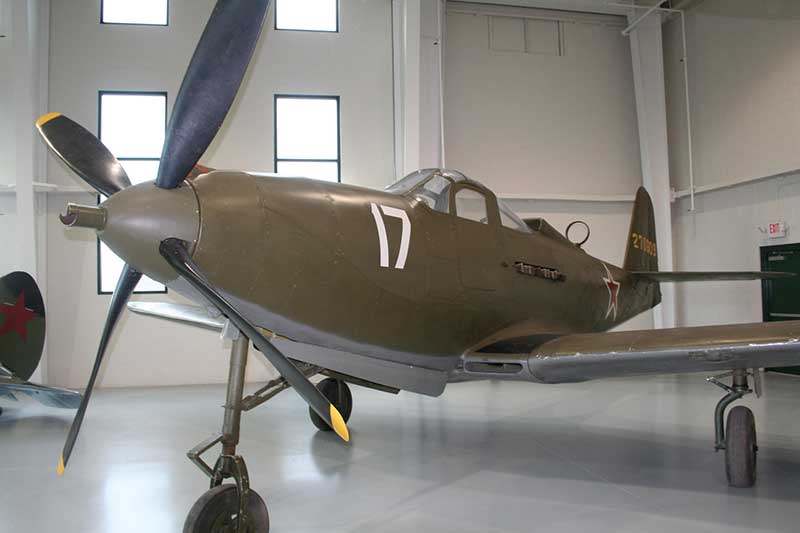
Based on the P-39 Aircobra, the P-63 was delivered in 1943. Several unique features characterize the plane, including tricycle gear, cannon firing through the propeller hub, automotive-style cockpit door, and mid-fuselage engine installation.
The P-63 proved to be a solid ground attack platform, and was used by the Soviets for killing German tanks and general low-level work. The vast majority of P-63’s were sent to Russia via Alaska and Iran, although some were used by the Free French Air Force. None are known to have seen combat with U.S. Forces.
The MAM P-63 is one of a group that were engaged against Japanese forces at the extreme eastern Russian territory at the end of WWII. Several P-63’s were found after 60 years of open storage.
Country: USA
Manufacturer: Bell Aircraft Co.
Engine: V-1710
Horsepower: 1000 hp
Max Speed: 410 mph
Weight: 10,700 lbs
Ceiling: 43,000 feet
Wing Span: 32ft 4in
Length: 32ft 8 in
Crew: One -
Lavochkin “LA-9″

The La-9 “Fritz” was developed by the Soviets as an early post WWII improvement on the earlier La-126 prototype.
First flown and accepted in 1946, the new fighter was all metal compared to partially wood, and it had a new laminar flow wing, much like the U.S. developed for the P-51.
The La-9 had greater fuel capacity and better armament than its predecessor, but it was inferior to the Yakovlev Yak-3, and production was ended less than two full years later in 1948.
Variants included adding a pulse-jet engine under each wing, but the resulting small airspeed increase came at the cost of poor handling, vibration, and noise.
Country: Russia
Manufacturer: Lavochkin
Engine:
Horsepower:
Max Speed: 428 mph
Weight: 8104 lbs
Ceiling: 35,433 feet
Range:
Wing Span:
Length:
Height: -
Polikarpov “I-15bis”
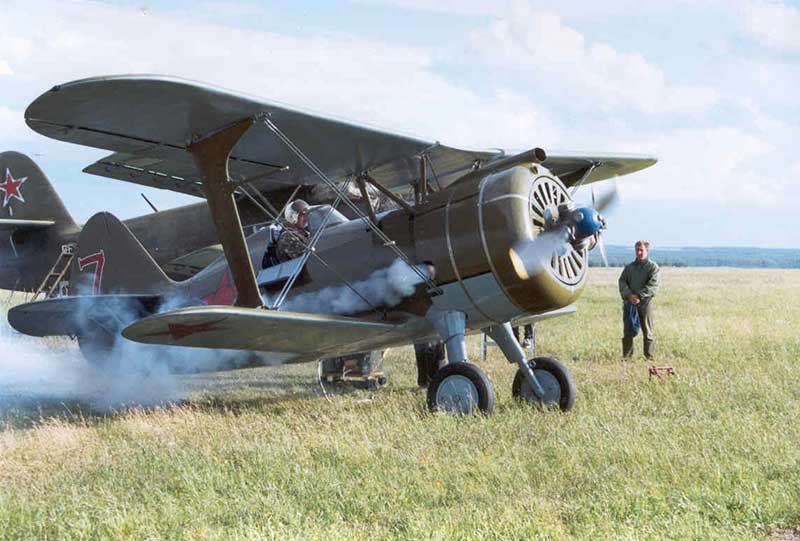
An improved second-generation (“bis”) version of the I-15 corrected the visibility and stability concerns of the original. It was the most-produced Soviet fighter plane of the pre-war era, and Soviet Air Force pilots held the plane in high regard due to its stability and combat handling.
By 1941, the aircraft was mostly used for observation, patrol, anti-submarine defense, and night attacks. They were in use all the way up to 1945, and for some years in Mongolia after that.
MAM’s “bis” is believed to be the only example remaining. It was found wrecked in Northern Russia, and was fully restored in time to fly in the 2001 Moscow Air Show.
Country: Russia
Manufacturer: Polikarpov
Engine: Ash-621R
Horsepower: 1,000 hp
Max Speed: 230 mph
Weight: 2,880 lbs
Ceiling: 23,800 feet
Range: 330 miles
Wing Span: 32′
Length: 20′
Height: 7′ 3″ -
Polikarpov “I-153 “Chaika"
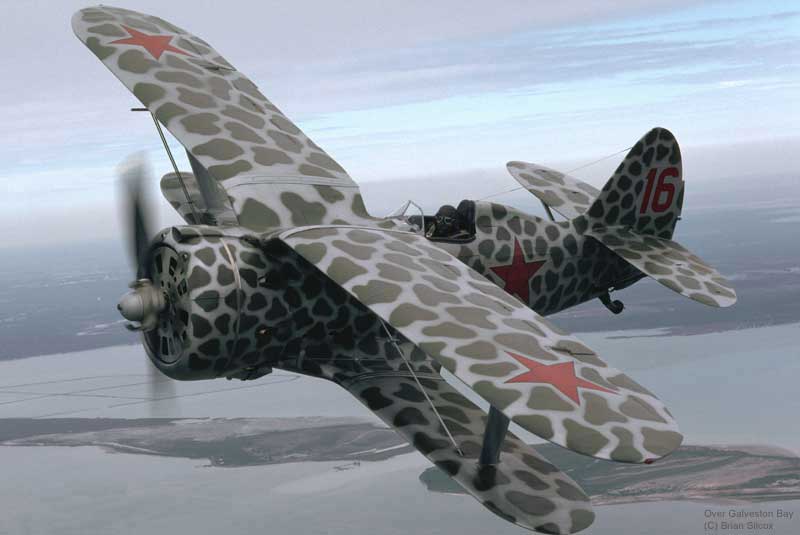
The I-153 was the third version of the venerable 1930’s biplane fighter, the I-15. It saw limited use, but did fly against the Japanese in Mongolia. This version returned to the original gull-wing design for the top wing, and was given the nickname “Chaika”, or “seagull”. It also had a larger engine and fully retractable landing gear.
The Fighter Factory’s 1938 Polikarpov I-153 was found in a swamp outside of Murmansk. This aircraft, serial number 6316, once flew with the 2nd Aviation Fighter Squadron of the Northern Navy. After being restored in Russia in 1998, this plane performed at air shows in New Zealand.
Country: Russia
Manufacturer: Polikarpov
Engine: Ash-62 IR
Horsepower: 1,000 hp
Max Speed: 220 mph
Weight: 3,285/ 4,279 lbs
Ceiling: 36,089 feet
Range: 490 miles
Wing Span: 32′
Length: 20′ 3″
Height: 9′ 10″ -
Polikarpov “I-16 “Rata”
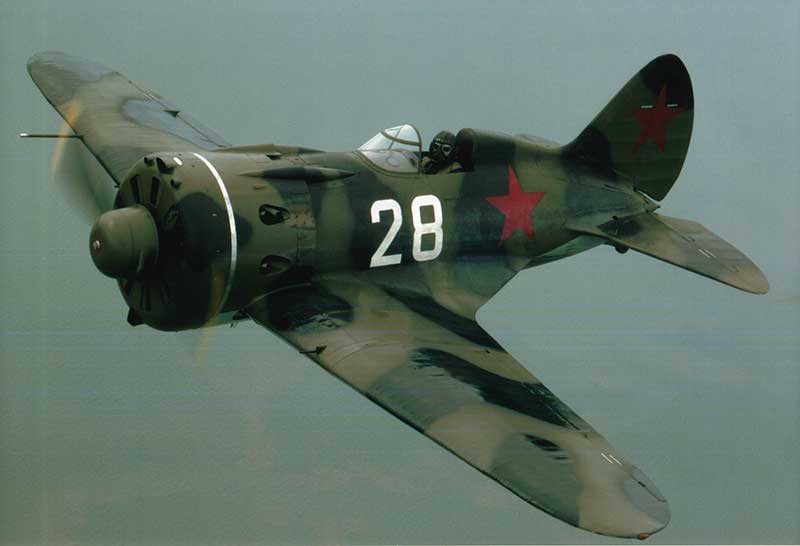
In 1933, Polikarpov broke away from his biplane designs and worked on the world’s first cantilever-wing monoplane design with fully retractable landing gear. The “rat” was considered more difficult to fly than earlier models, so a two-cockpit design was rushed into production for dual instruction.
The “rat” was underestimated by many opposing pilots due to it’s ungainly appearance, but it’s speed and firepower were more impressive than it’s looks.
The I-16 was definitely a front-line fighter at the outbreak of WWII, but as early as 1941 it was beginning to be outclassed by most opposing fighter aircraft. This particular plane was built in 1939 according to the data plate found at the crash site near the Finnish border
Country: Russia
Manufacturer: Polikarpov
Engine: Ash-62 IR
Horsepower: 1,000 hp
Max Speed: 260 mph
Weight: 3,285/ 4,279 lbs
Ceiling: 31,825 feet
Range: 490 miles
Wing Span: 32′
Length: 20′ 1″
Height: 7′ 3″ -
Yakovlev Yak-3M “MAX Replica”
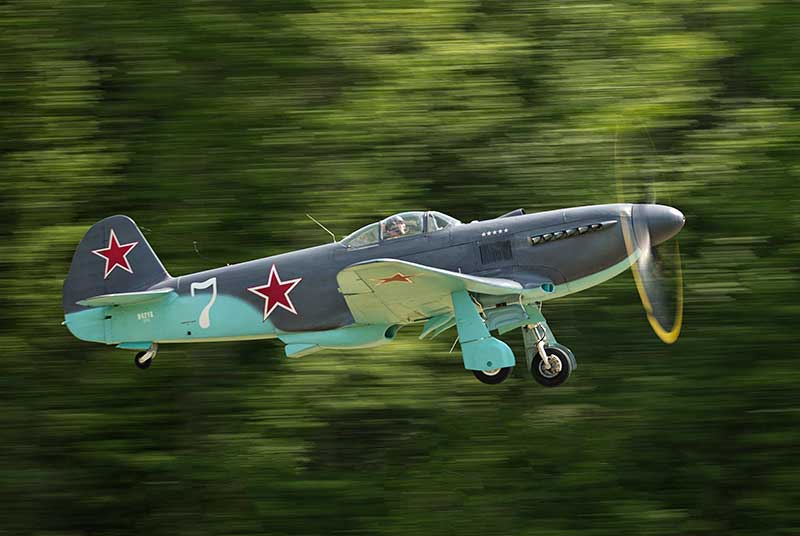
Introduced in 1944, the Yak-2 was a Soviet fighter aircraft. It was lighter and smaller than most fighters, and it was regarded by some as superior to the Spitfire and Mustang for pure dogfighting ability due to its’ high power-to-weight ratio.
Several combat engagements between numerically superior German planes and Yaks led to a Luftwaffe command to “avoid combat with Yak fighters …” because as many as 15 Germans were shot down for each Yak lost.
The museum’s Yak-3 is a rare case among warbirds. In 1991 Yakovlev used original parts and dies to build, new, a number of Yak-3 replicas which were given the suffix “M” to distinguish them from original production models. The “M” model is largely different from original models in it’s use of the Allison engine.
Country: Russia
Manufacturer: Yakovlev
Engine: Klimov VK-105
Horsepower: 1,300 hp
Max Speed:407 mph
Weight: 5,864 lbs
Ceiling: 35,000 feet
Crew: One
Armament: 1 x 20 cannon, 2 x 12.7mm MGs

